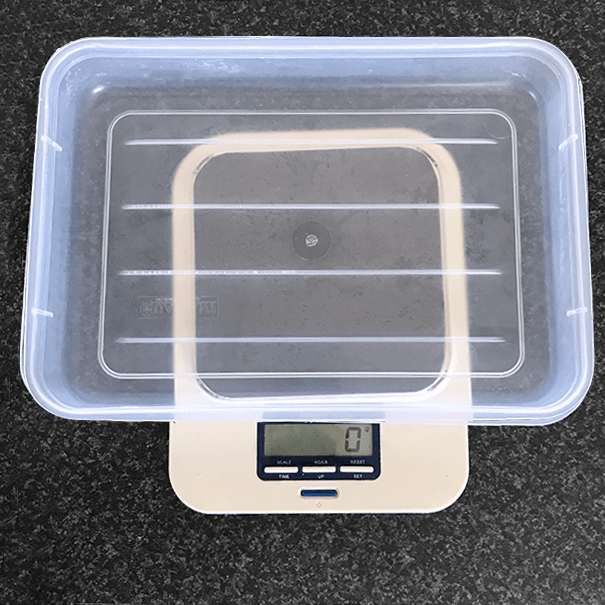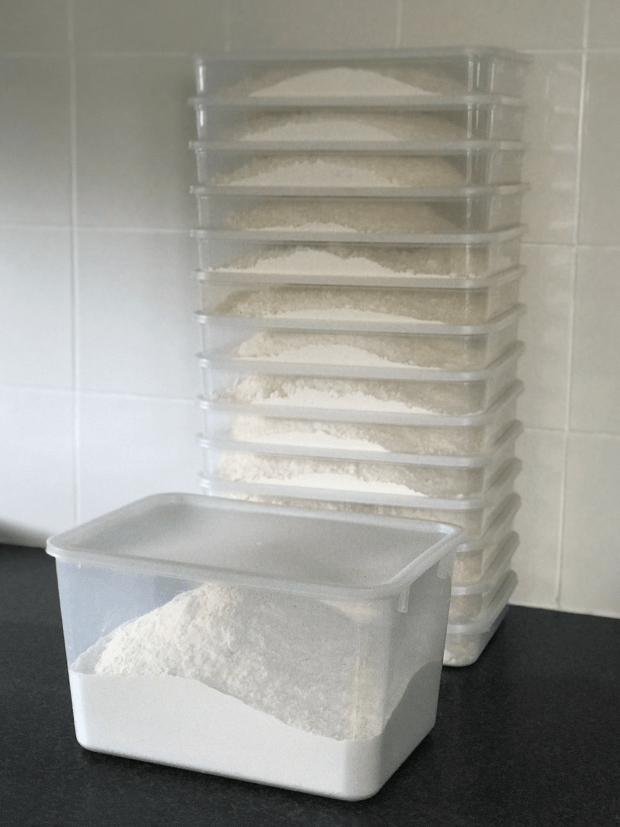In bread flour storage – made easy, I suggested storing your bread flour as pre-measured, ready to use bread mix. This method will work for any bread recipe but the portions in this recipe are designed for our no-knead sourdoughs.
How long does it take to make bread mix?
8 minutes for a 5kg bag of bread flour.
Makes 10 loaves
I buy bread flour in bulk and it takes me 20 minutes is all it takes to decant a massive 12.5kg bag of bread flour with salt into 14 containers. 20 minutes for 28 loaves of bread! It’s so worth it!
I always make two loaves at the same time, so when making my own bread mix I measure a double portion of bread four and salt mix into each container, making a double portion of bread mix. The below method is for a single loaf.
Equipment
Digital scales
Large scoop
Jars, Tupperware containers or zip lock bags all of the same size.
TIP: Choose containers to suit the volume of flour (415g) that you will be storing in each one. I use large containers that store 830g flour, which is a double mix.
Ingredients
415g Bread Flour (Not all-purpose flour. Read about flour here and where to get it in Australia here)
9g Salt (I use pink salt but any salt will work)
How to do it
Keep aside 20% of the bread flour for feeding your sourdough. Store it in its own unique container and when making sourdough, keep it somewhere handy!
20% of…
1kg bag is 200g
2kg bag is 400g
5kg bag is 850g
10kg bag is 2kg
12.5kg bag is 3kg
1. Tare your scales*
Place one of your empty bread mix storage containers onto your scales and zero the weight.

2. Measure your Bread Flour
Weigh 415g of bread flour directly into your container.

TIP: Before you zero the scales to add the salt (and have to re-zero them again for the next container) consider these two easier options:
A) Measure all flour, then all salt
Measure all your flour first without re-taring your scales, then using just one of your containers filled with flour, zero your scales once and use this tare to add the salt measurement to each container (e.g your scales will show 9g when you add the salt)
OR
B) Use some maths to measure both at once
Know what your combined weight should be: (flour + salt = total weight).
415g bread flour + 9g salt = 424g.
or
830g bread flour +18g salt = 848g.
Once you have the flour measurement showing on the screen you can add salt until you reach the total weight. You don’t need to zero the scales again at all. This is the method I use because there is one less step involved!

3. Seal
Close the container tightly and repeat the process until 80% of your flour is ready to store.
4. Non-mix flour
The remaining 20% of bread flour is used to activate your starter. It’s important that its not mixed with salt and stored in it’s own large jar, ziplock bag or tupperware container. Label it ‘Bread Flour only’) so you remember and store it somewhere easy to reach when you are making your loaves. You will use it several times each time you make sourdough bread.

*If you use all the same containers, you won’t have to tare the scales each time, when one is done, you can take it off and place the next on one and go again.

